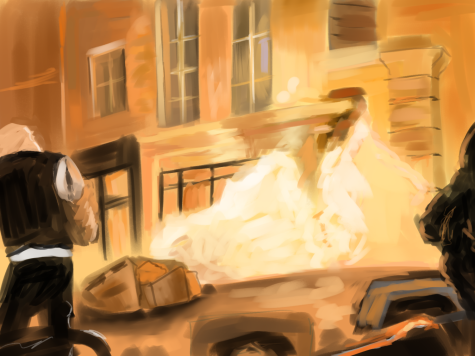The Fight in Mosul
December 10, 2016
The renewed assault on Mosul, Iraq, started nearly a month ago on October 17. The operation, consisting of 30,000 total troops, was launched to take back Iraq’s second-largest city and one of the Islamic State’s (IS) last major strongholds in the Middle Eastern country.
In the second year of IS occupation, residents of the major industrial city and trade hub are being held by the IS. Food rations are projected to be available for only 220,000 families; emergency items are projected to be available for only 143,000 people.
This forces the remaining IS members in the city to make a hard decision: flee, and find themselves branded traitors in an unfamiliar place, or stay, and run the impending risk of being shot by liberation fighters.
Although the fighters of the coalition and IS are the ones on the front lines, civilians may ultimately be paying the heaviest price in the bid to liberate Mosul. One major tactic of IS fighters is using civilians as human shields in order to assure the fighters’ own immunity. In fact, IS kidnapped almost 8,000 families from the districts surrounding Mosul— held at gunpoint, the people must either stand their ground and get shot, or go with the fighters. Thus, 1.5 million citizens are now stuck in the city.
In Hamam al-Alil, another area occupied by IS, the civilian population has risen due to the kidnappings by the fighters — now 60,000, a sharp contrast to the former number of 23,000. As civilians are pulled from their homes, they are forced into occupied areas, and the population rises.
Amidst shootings and civilian executions, residents of Mosul face another danger: displacement. The operation on Mosul alone has displaced 56,000 people, with an additional 100,000 having fled the region.
In the city, the citizens have become targets of the militants’ anger: last Tuesday, a human rights group allegedly obtained footage of citizens being dragged, executed or mutilated by IS members as fear grows over the approaching liberation forces.
IS has also been silencing dissenters, recently executing 42 civilians as well as 214 former Iraqi security forces for refusing to join them.
As for the mechanics of the actual assault, Iraqi troops managed to reach Mosul’s eastern border on October 31, after two weeks of fighting. Between then and November 4, troops have managed to establish holds on certain districts should they lose hold of Mosul again.
One of the major obstacles the troops face is the terrain itself. It is purported to be mine-filled and booby-trapped. Furthermore, reports show that enemy fighters are lying in wait in tunnels, ready to strike. Even so, troops have managed to advance on different fronts, but they still face strong resistance from the IS’ counterattacks in other areas of Iraq. The operation to retake Mosul has been the result of months of planning, and involves Iraqi, Kurdish, Sunni, and Shia troops. It is projected to last for at least a couple weeks.
In terms of the U.S.’s participation, Collin Montag ’17 remarks, “I think we should avoid any ground deployment, simply because of the history we have in the region and how difficult pulling out from that type of involvement has proven to be. Funding and less committal military support can be a huge help to ousting extremism, though.”
On the contrary, Aditi Sharma ’20 adds, “I think that as a world leader the US should be trying to maintain global peace, so our interference in Mosul is okay as long as we are standing up for the people who really need our help.”
Perspectives like Collin’s convey the wariness throughout the public of the associated risks of participating in the assault on Mosul, while those like Aditi’s display a willingness to fight if it means reaching peace.
As the assault on Mosul enters its second month, the outcome remains unclear. Whether the citizens finally have their freedom or continue to fight on is ultimately in the hands of the global leaders heading the operation to liberate Mosul.


